Network Analysis using Wireshark: MN504 Application Management
VerifiedAdded on 2023/06/11
|23
|2463
|172
Report
AI Summary
This report provides an analytical understanding of the management and performance of networked applications using Wireshark. It analyzes three different networks, capturing packets to provide insights into network performance and traffic. The report details the capture time, total number of packets, and client/server IP addresses for each network. It also determines throughput, round trip time, and TCP retransmissions, comparing the networks to provide effective network information. Finally, it compares Wireshark with Microsoft Message Analyzer, highlighting the advantages of Wireshark for network analysis and monitoring. Desklib provides access to this and many other solved assignments.

NETWORK APPLICATION MANAGEMENT
Paraphrase This Document
Need a fresh take? Get an instant paraphrase of this document with our AI Paraphraser
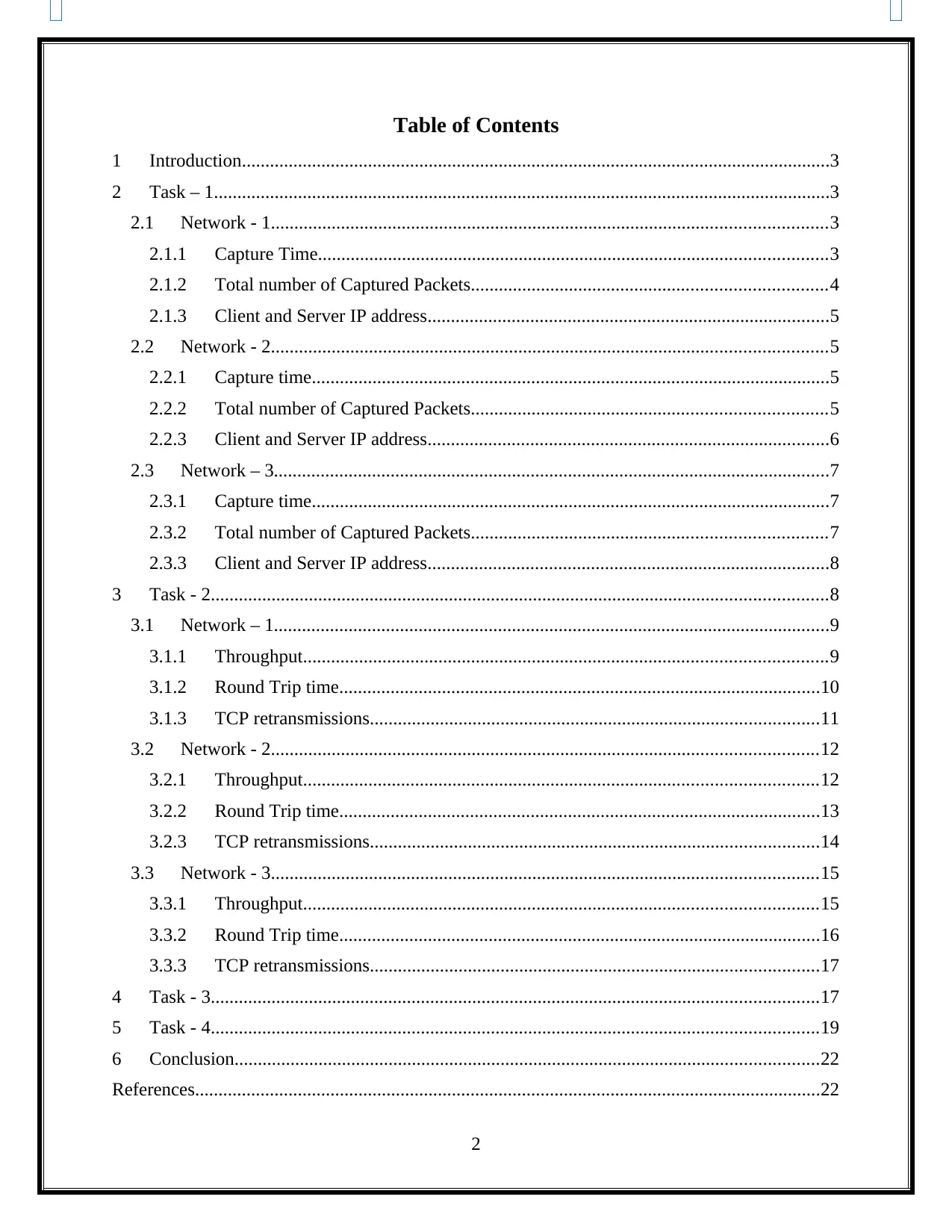
Table of Contents
1 Introduction..............................................................................................................................3
2 Task – 1....................................................................................................................................3
2.1 Network - 1.......................................................................................................................3
2.1.1 Capture Time.............................................................................................................3
2.1.2 Total number of Captured Packets............................................................................4
2.1.3 Client and Server IP address......................................................................................5
2.2 Network - 2.......................................................................................................................5
2.2.1 Capture time...............................................................................................................5
2.2.2 Total number of Captured Packets............................................................................5
2.2.3 Client and Server IP address......................................................................................6
2.3 Network – 3.......................................................................................................................7
2.3.1 Capture time...............................................................................................................7
2.3.2 Total number of Captured Packets............................................................................7
2.3.3 Client and Server IP address......................................................................................8
3 Task - 2....................................................................................................................................8
3.1 Network – 1.......................................................................................................................9
3.1.1 Throughput................................................................................................................9
3.1.2 Round Trip time.......................................................................................................10
3.1.3 TCP retransmissions................................................................................................11
3.2 Network - 2.....................................................................................................................12
3.2.1 Throughput..............................................................................................................12
3.2.2 Round Trip time.......................................................................................................13
3.2.3 TCP retransmissions................................................................................................14
3.3 Network - 3.....................................................................................................................15
3.3.1 Throughput..............................................................................................................15
3.3.2 Round Trip time.......................................................................................................16
3.3.3 TCP retransmissions................................................................................................17
4 Task - 3..................................................................................................................................17
5 Task - 4..................................................................................................................................19
6 Conclusion.............................................................................................................................22
References......................................................................................................................................22
2
1 Introduction..............................................................................................................................3
2 Task – 1....................................................................................................................................3
2.1 Network - 1.......................................................................................................................3
2.1.1 Capture Time.............................................................................................................3
2.1.2 Total number of Captured Packets............................................................................4
2.1.3 Client and Server IP address......................................................................................5
2.2 Network - 2.......................................................................................................................5
2.2.1 Capture time...............................................................................................................5
2.2.2 Total number of Captured Packets............................................................................5
2.2.3 Client and Server IP address......................................................................................6
2.3 Network – 3.......................................................................................................................7
2.3.1 Capture time...............................................................................................................7
2.3.2 Total number of Captured Packets............................................................................7
2.3.3 Client and Server IP address......................................................................................8
3 Task - 2....................................................................................................................................8
3.1 Network – 1.......................................................................................................................9
3.1.1 Throughput................................................................................................................9
3.1.2 Round Trip time.......................................................................................................10
3.1.3 TCP retransmissions................................................................................................11
3.2 Network - 2.....................................................................................................................12
3.2.1 Throughput..............................................................................................................12
3.2.2 Round Trip time.......................................................................................................13
3.2.3 TCP retransmissions................................................................................................14
3.3 Network - 3.....................................................................................................................15
3.3.1 Throughput..............................................................................................................15
3.3.2 Round Trip time.......................................................................................................16
3.3.3 TCP retransmissions................................................................................................17
4 Task - 3..................................................................................................................................17
5 Task - 4..................................................................................................................................19
6 Conclusion.............................................................................................................................22
References......................................................................................................................................22
2
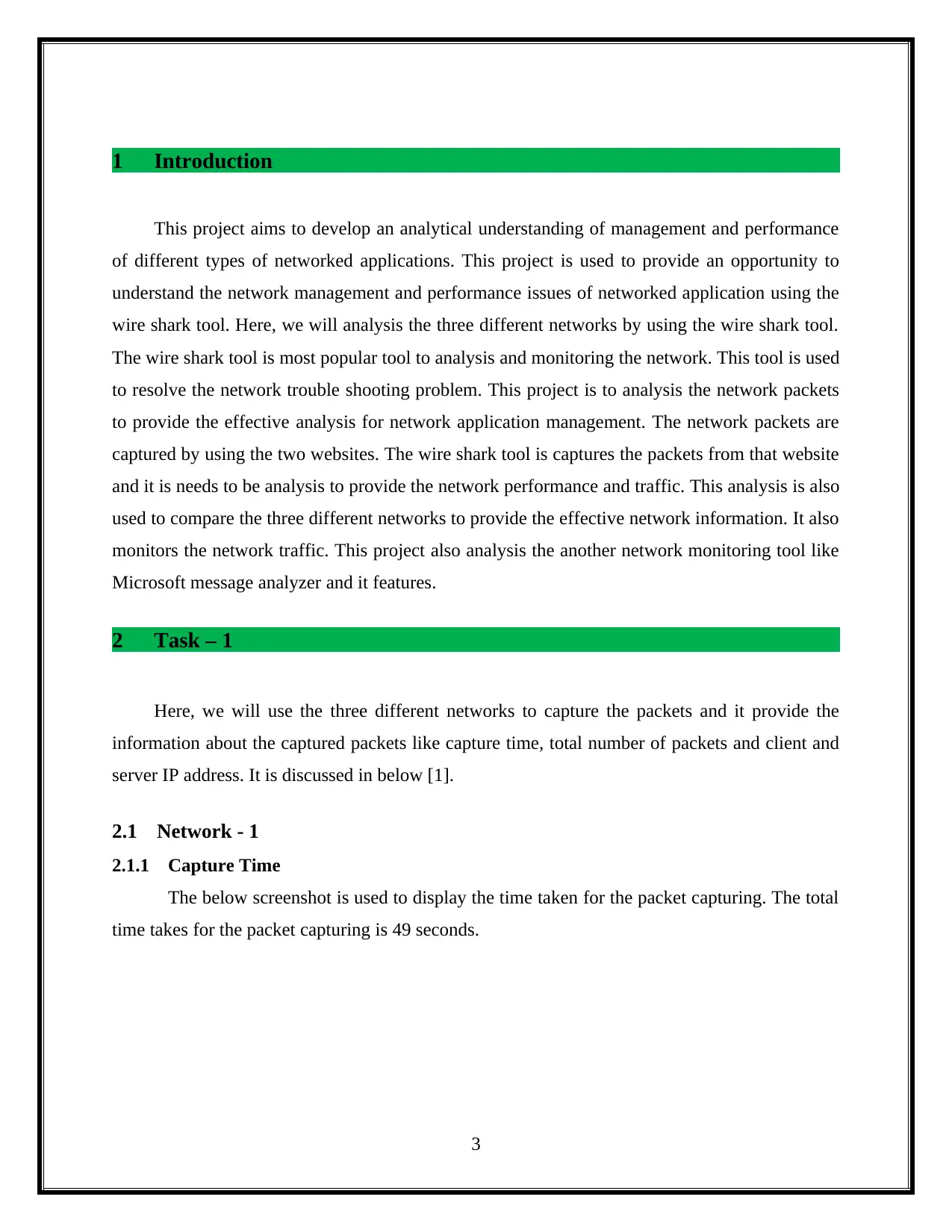
1 Introduction
This project aims to develop an analytical understanding of management and performance
of different types of networked applications. This project is used to provide an opportunity to
understand the network management and performance issues of networked application using the
wire shark tool. Here, we will analysis the three different networks by using the wire shark tool.
The wire shark tool is most popular tool to analysis and monitoring the network. This tool is used
to resolve the network trouble shooting problem. This project is to analysis the network packets
to provide the effective analysis for network application management. The network packets are
captured by using the two websites. The wire shark tool is captures the packets from that website
and it is needs to be analysis to provide the network performance and traffic. This analysis is also
used to compare the three different networks to provide the effective network information. It also
monitors the network traffic. This project also analysis the another network monitoring tool like
Microsoft message analyzer and it features.
2 Task – 1
Here, we will use the three different networks to capture the packets and it provide the
information about the captured packets like capture time, total number of packets and client and
server IP address. It is discussed in below [1].
2.1 Network - 1
2.1.1 Capture Time
The below screenshot is used to display the time taken for the packet capturing. The total
time takes for the packet capturing is 49 seconds.
3
This project aims to develop an analytical understanding of management and performance
of different types of networked applications. This project is used to provide an opportunity to
understand the network management and performance issues of networked application using the
wire shark tool. Here, we will analysis the three different networks by using the wire shark tool.
The wire shark tool is most popular tool to analysis and monitoring the network. This tool is used
to resolve the network trouble shooting problem. This project is to analysis the network packets
to provide the effective analysis for network application management. The network packets are
captured by using the two websites. The wire shark tool is captures the packets from that website
and it is needs to be analysis to provide the network performance and traffic. This analysis is also
used to compare the three different networks to provide the effective network information. It also
monitors the network traffic. This project also analysis the another network monitoring tool like
Microsoft message analyzer and it features.
2 Task – 1
Here, we will use the three different networks to capture the packets and it provide the
information about the captured packets like capture time, total number of packets and client and
server IP address. It is discussed in below [1].
2.1 Network - 1
2.1.1 Capture Time
The below screenshot is used to display the time taken for the packet capturing. The total
time takes for the packet capturing is 49 seconds.
3
⊘ This is a preview!⊘
Do you want full access?
Subscribe today to unlock all pages.

Trusted by 1+ million students worldwide
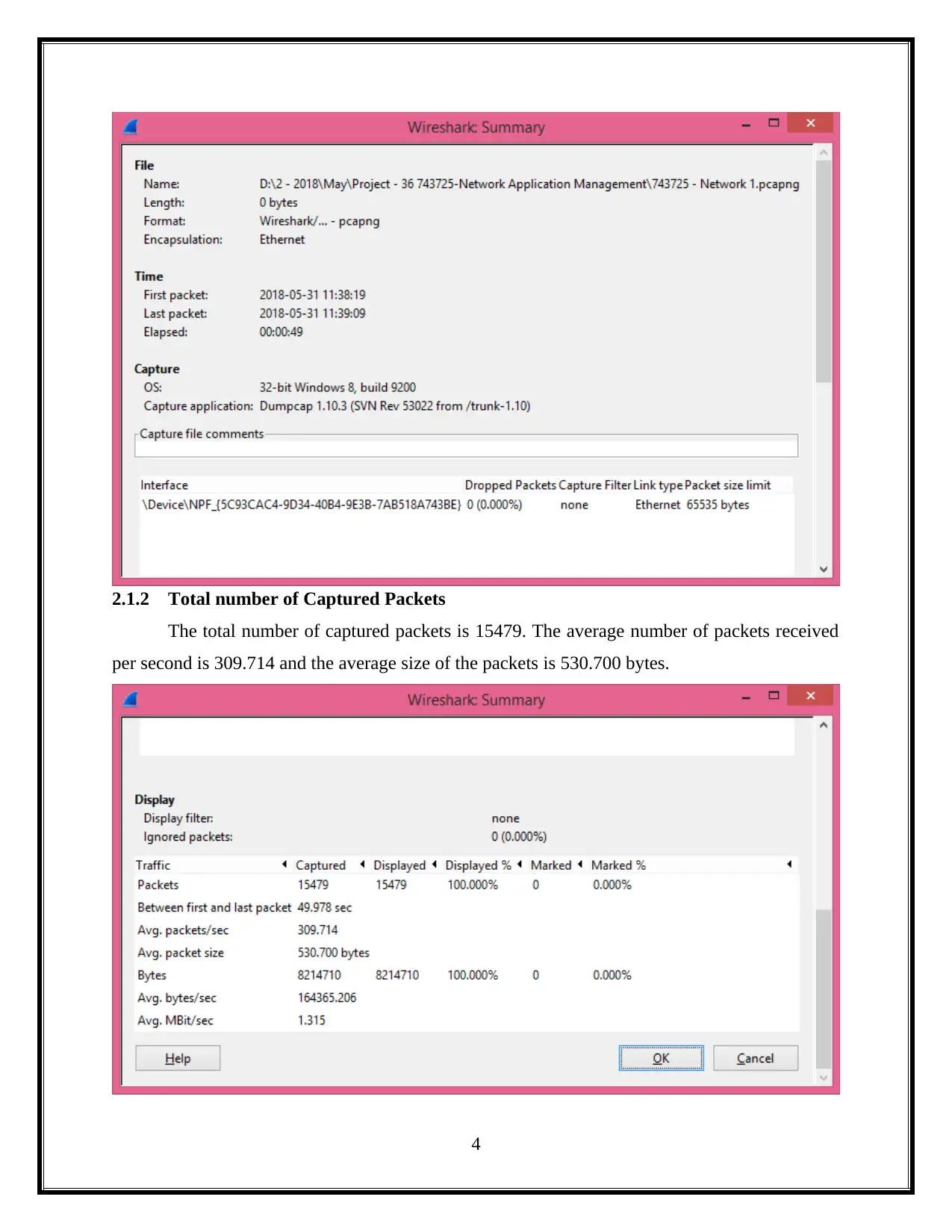
2.1.2 Total number of Captured Packets
The total number of captured packets is 15479. The average number of packets received
per second is 309.714 and the average size of the packets is 530.700 bytes.
4
The total number of captured packets is 15479. The average number of packets received
per second is 309.714 and the average size of the packets is 530.700 bytes.
4
Paraphrase This Document
Need a fresh take? Get an instant paraphrase of this document with our AI Paraphraser
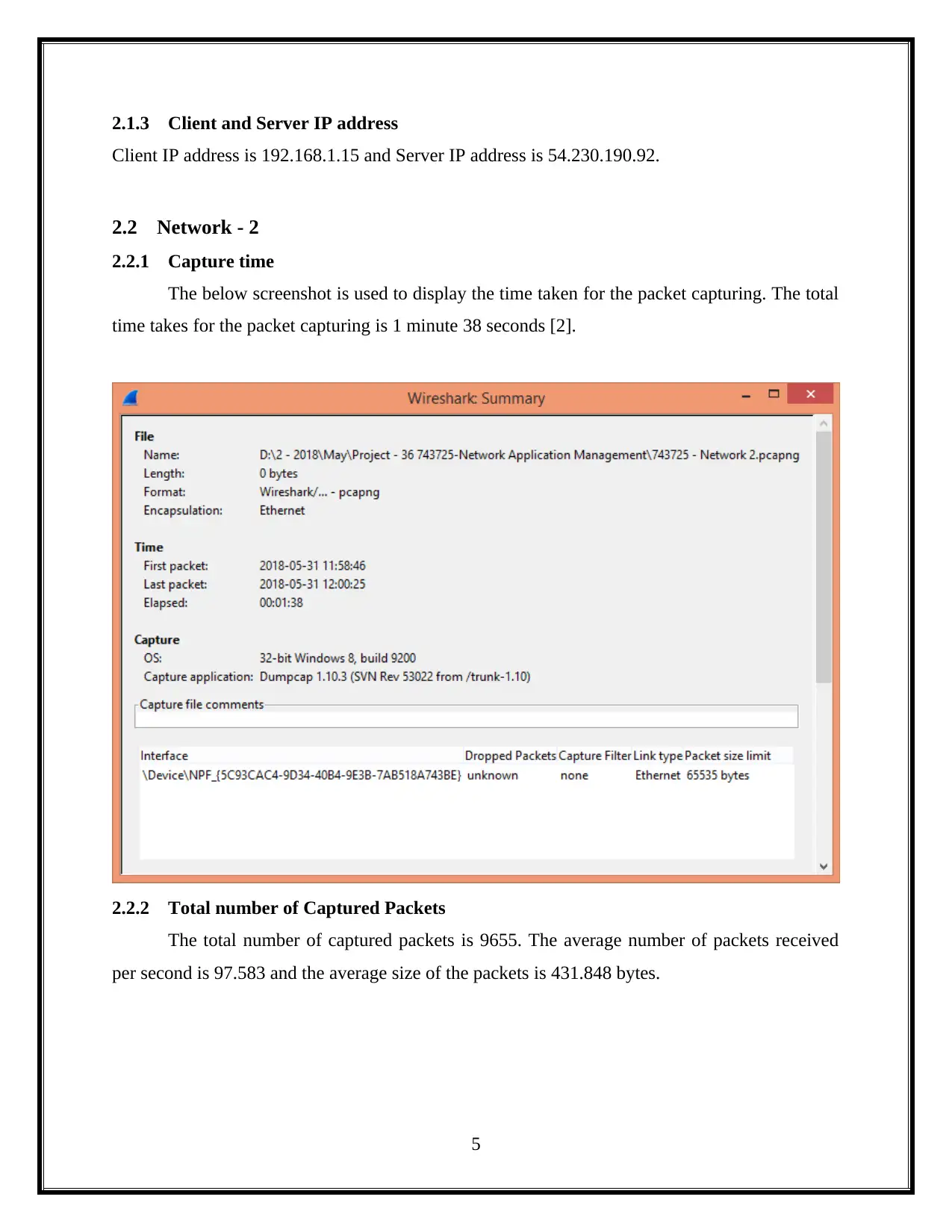
2.1.3 Client and Server IP address
Client IP address is 192.168.1.15 and Server IP address is 54.230.190.92.
2.2 Network - 2
2.2.1 Capture time
The below screenshot is used to display the time taken for the packet capturing. The total
time takes for the packet capturing is 1 minute 38 seconds [2].
2.2.2 Total number of Captured Packets
The total number of captured packets is 9655. The average number of packets received
per second is 97.583 and the average size of the packets is 431.848 bytes.
5
Client IP address is 192.168.1.15 and Server IP address is 54.230.190.92.
2.2 Network - 2
2.2.1 Capture time
The below screenshot is used to display the time taken for the packet capturing. The total
time takes for the packet capturing is 1 minute 38 seconds [2].
2.2.2 Total number of Captured Packets
The total number of captured packets is 9655. The average number of packets received
per second is 97.583 and the average size of the packets is 431.848 bytes.
5
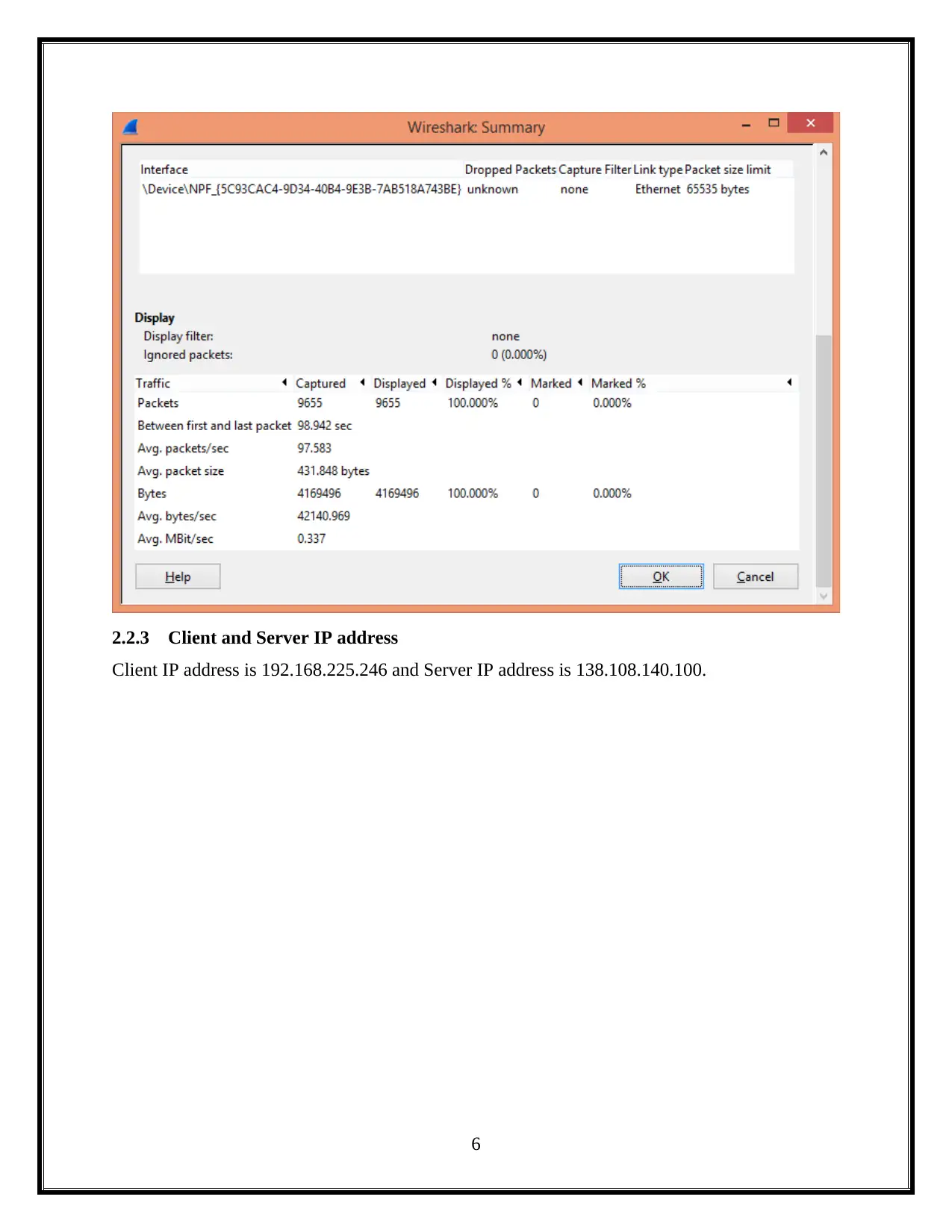
2.2.3 Client and Server IP address
Client IP address is 192.168.225.246 and Server IP address is 138.108.140.100.
6
Client IP address is 192.168.225.246 and Server IP address is 138.108.140.100.
6
⊘ This is a preview!⊘
Do you want full access?
Subscribe today to unlock all pages.

Trusted by 1+ million students worldwide
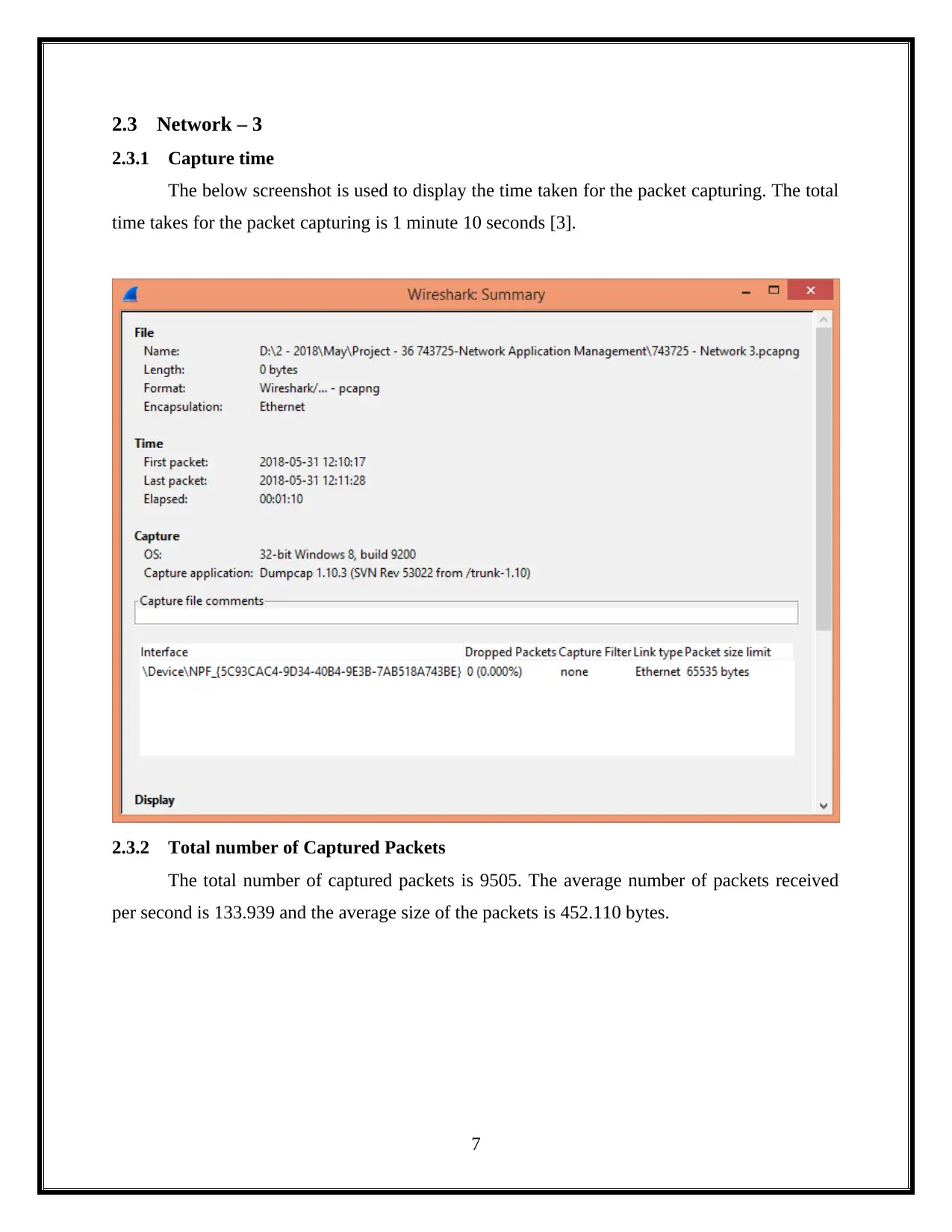
2.3 Network – 3
2.3.1 Capture time
The below screenshot is used to display the time taken for the packet capturing. The total
time takes for the packet capturing is 1 minute 10 seconds [3].
2.3.2 Total number of Captured Packets
The total number of captured packets is 9505. The average number of packets received
per second is 133.939 and the average size of the packets is 452.110 bytes.
7
2.3.1 Capture time
The below screenshot is used to display the time taken for the packet capturing. The total
time takes for the packet capturing is 1 minute 10 seconds [3].
2.3.2 Total number of Captured Packets
The total number of captured packets is 9505. The average number of packets received
per second is 133.939 and the average size of the packets is 452.110 bytes.
7
Paraphrase This Document
Need a fresh take? Get an instant paraphrase of this document with our AI Paraphraser
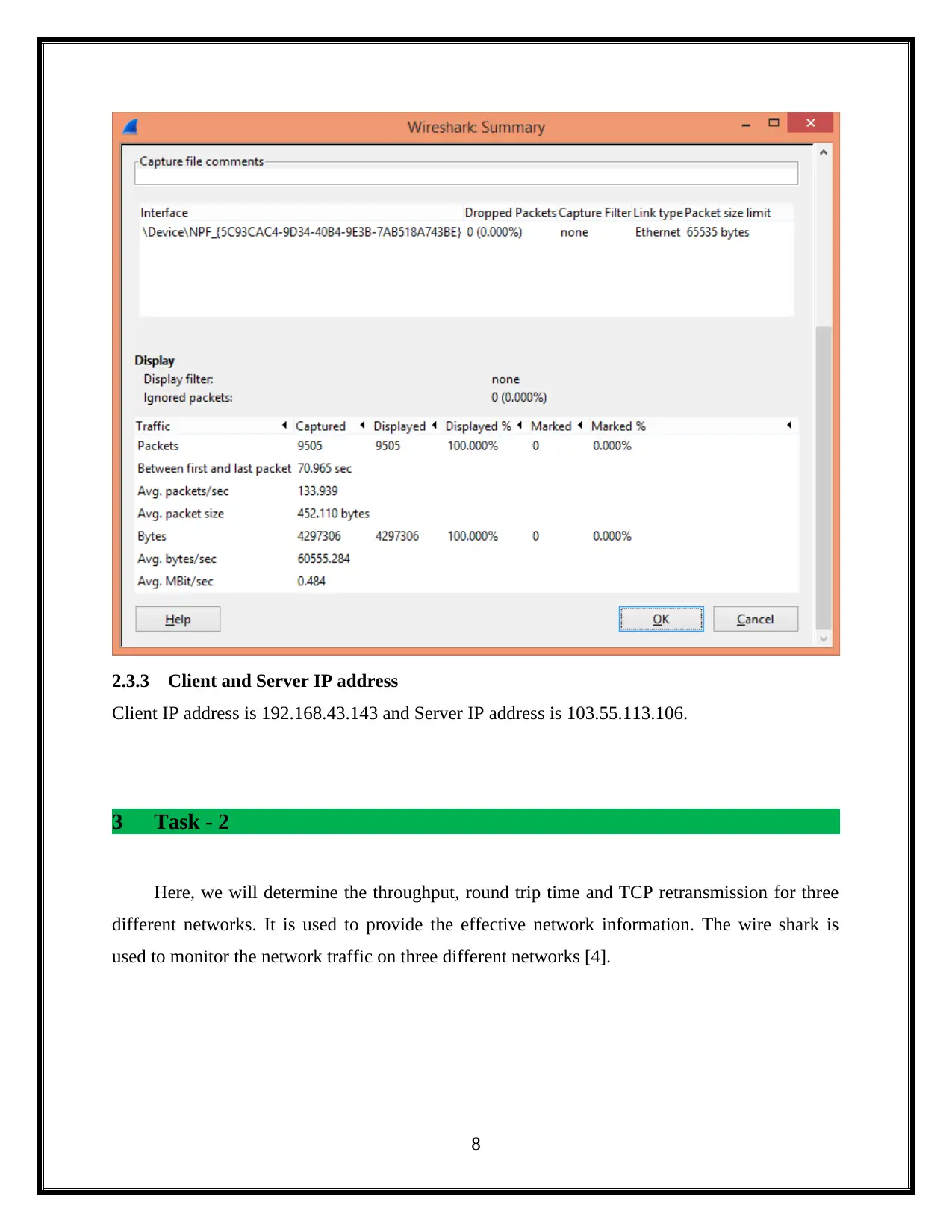
2.3.3 Client and Server IP address
Client IP address is 192.168.43.143 and Server IP address is 103.55.113.106.
3 Task - 2
Here, we will determine the throughput, round trip time and TCP retransmission for three
different networks. It is used to provide the effective network information. The wire shark is
used to monitor the network traffic on three different networks [4].
8
Client IP address is 192.168.43.143 and Server IP address is 103.55.113.106.
3 Task - 2
Here, we will determine the throughput, round trip time and TCP retransmission for three
different networks. It is used to provide the effective network information. The wire shark is
used to monitor the network traffic on three different networks [4].
8
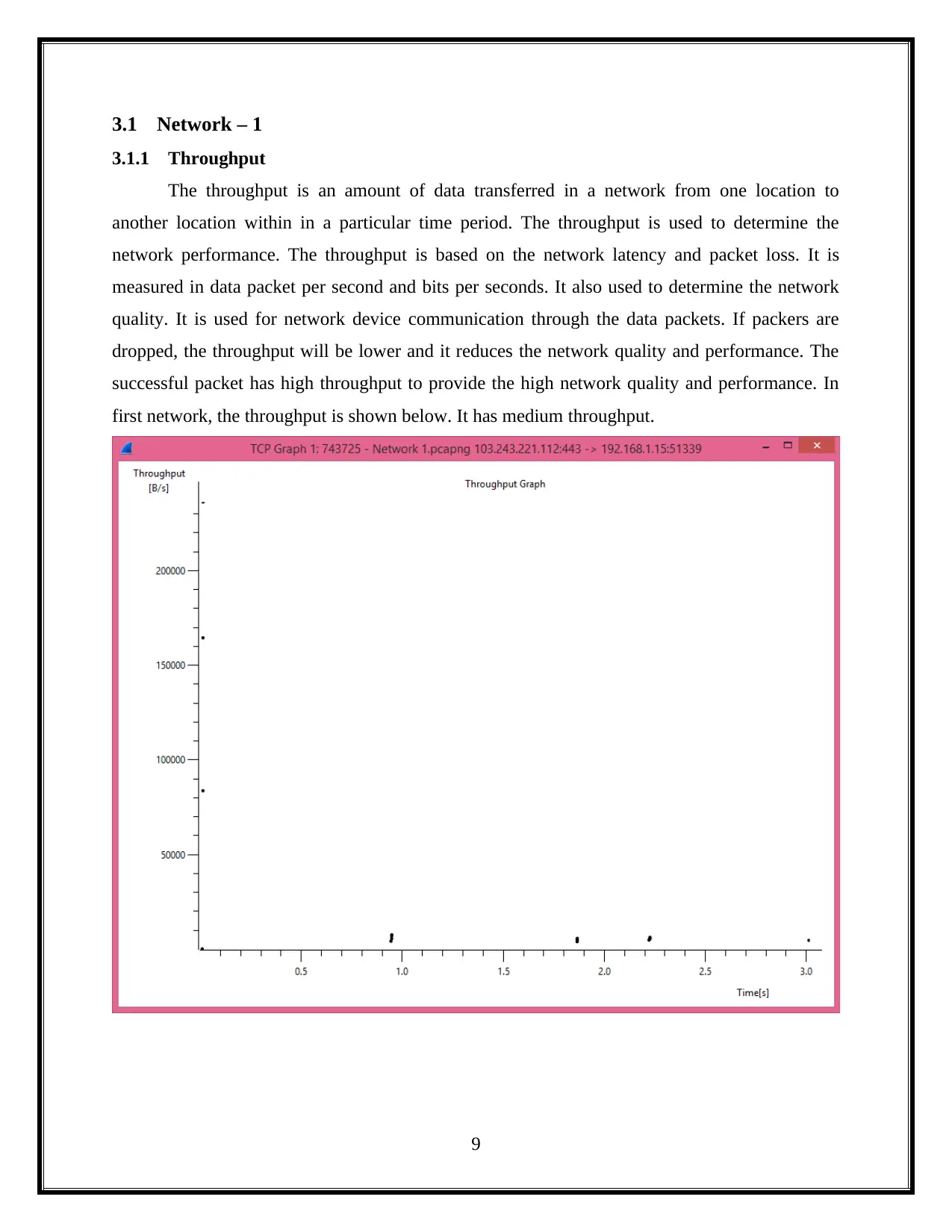
3.1 Network – 1
3.1.1 Throughput
The throughput is an amount of data transferred in a network from one location to
another location within in a particular time period. The throughput is used to determine the
network performance. The throughput is based on the network latency and packet loss. It is
measured in data packet per second and bits per seconds. It also used to determine the network
quality. It is used for network device communication through the data packets. If packers are
dropped, the throughput will be lower and it reduces the network quality and performance. The
successful packet has high throughput to provide the high network quality and performance. In
first network, the throughput is shown below. It has medium throughput.
9
3.1.1 Throughput
The throughput is an amount of data transferred in a network from one location to
another location within in a particular time period. The throughput is used to determine the
network performance. The throughput is based on the network latency and packet loss. It is
measured in data packet per second and bits per seconds. It also used to determine the network
quality. It is used for network device communication through the data packets. If packers are
dropped, the throughput will be lower and it reduces the network quality and performance. The
successful packet has high throughput to provide the high network quality and performance. In
first network, the throughput is shown below. It has medium throughput.
9
⊘ This is a preview!⊘
Do you want full access?
Subscribe today to unlock all pages.

Trusted by 1+ million students worldwide
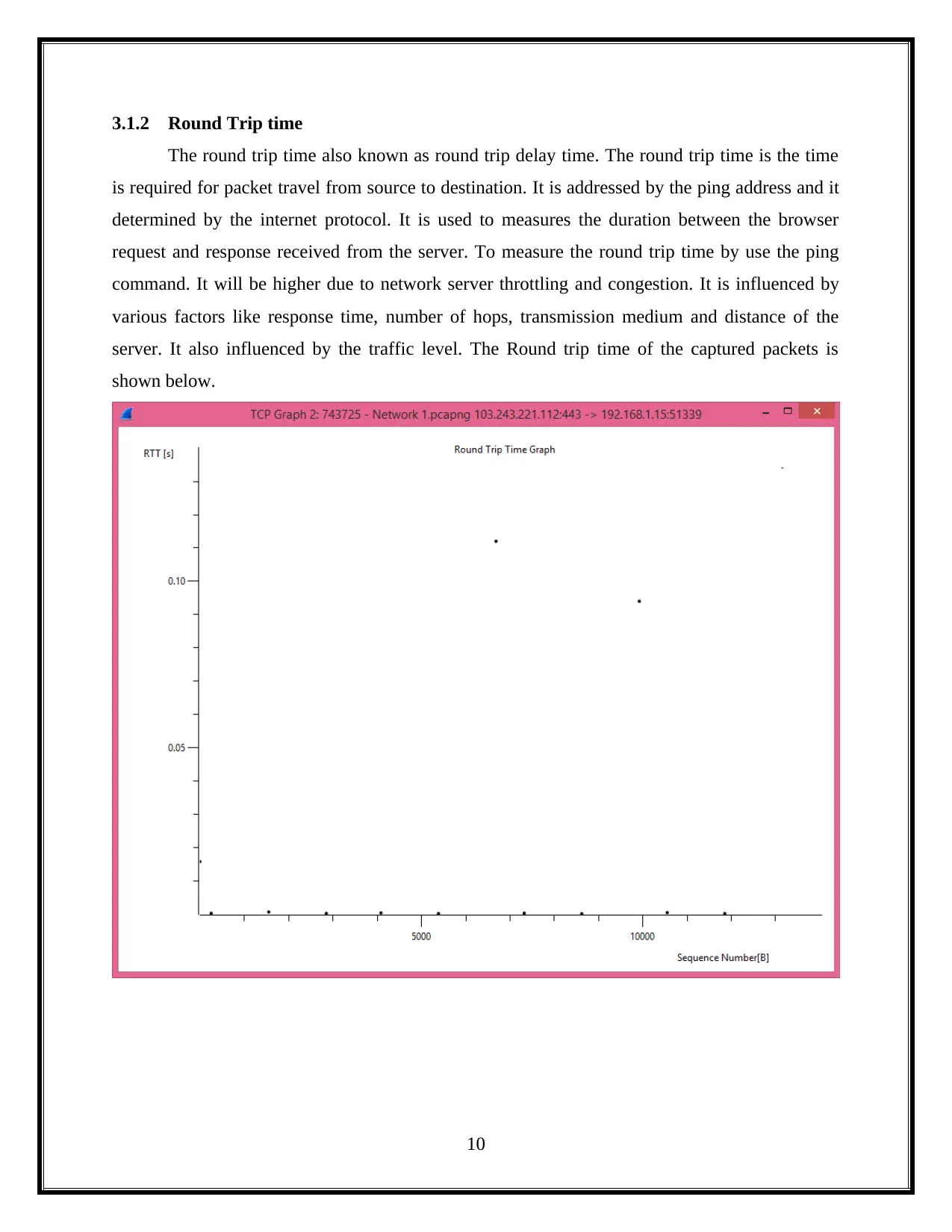
3.1.2 Round Trip time
The round trip time also known as round trip delay time. The round trip time is the time
is required for packet travel from source to destination. It is addressed by the ping address and it
determined by the internet protocol. It is used to measures the duration between the browser
request and response received from the server. To measure the round trip time by use the ping
command. It will be higher due to network server throttling and congestion. It is influenced by
various factors like response time, number of hops, transmission medium and distance of the
server. It also influenced by the traffic level. The Round trip time of the captured packets is
shown below.
10
The round trip time also known as round trip delay time. The round trip time is the time
is required for packet travel from source to destination. It is addressed by the ping address and it
determined by the internet protocol. It is used to measures the duration between the browser
request and response received from the server. To measure the round trip time by use the ping
command. It will be higher due to network server throttling and congestion. It is influenced by
various factors like response time, number of hops, transmission medium and distance of the
server. It also influenced by the traffic level. The Round trip time of the captured packets is
shown below.
10
Paraphrase This Document
Need a fresh take? Get an instant paraphrase of this document with our AI Paraphraser
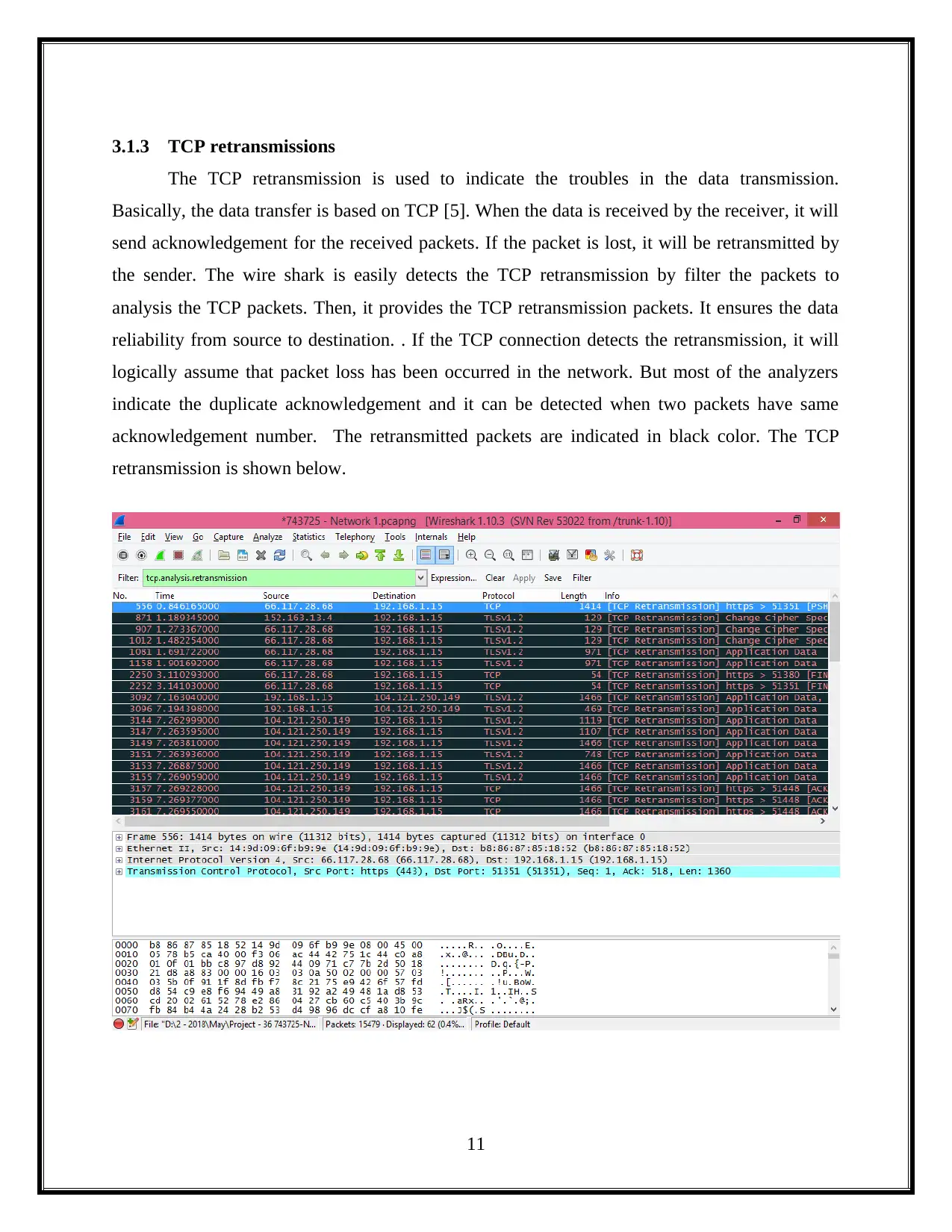
3.1.3 TCP retransmissions
The TCP retransmission is used to indicate the troubles in the data transmission.
Basically, the data transfer is based on TCP [5]. When the data is received by the receiver, it will
send acknowledgement for the received packets. If the packet is lost, it will be retransmitted by
the sender. The wire shark is easily detects the TCP retransmission by filter the packets to
analysis the TCP packets. Then, it provides the TCP retransmission packets. It ensures the data
reliability from source to destination. . If the TCP connection detects the retransmission, it will
logically assume that packet loss has been occurred in the network. But most of the analyzers
indicate the duplicate acknowledgement and it can be detected when two packets have same
acknowledgement number. The retransmitted packets are indicated in black color. The TCP
retransmission is shown below.
11
The TCP retransmission is used to indicate the troubles in the data transmission.
Basically, the data transfer is based on TCP [5]. When the data is received by the receiver, it will
send acknowledgement for the received packets. If the packet is lost, it will be retransmitted by
the sender. The wire shark is easily detects the TCP retransmission by filter the packets to
analysis the TCP packets. Then, it provides the TCP retransmission packets. It ensures the data
reliability from source to destination. . If the TCP connection detects the retransmission, it will
logically assume that packet loss has been occurred in the network. But most of the analyzers
indicate the duplicate acknowledgement and it can be detected when two packets have same
acknowledgement number. The retransmitted packets are indicated in black color. The TCP
retransmission is shown below.
11
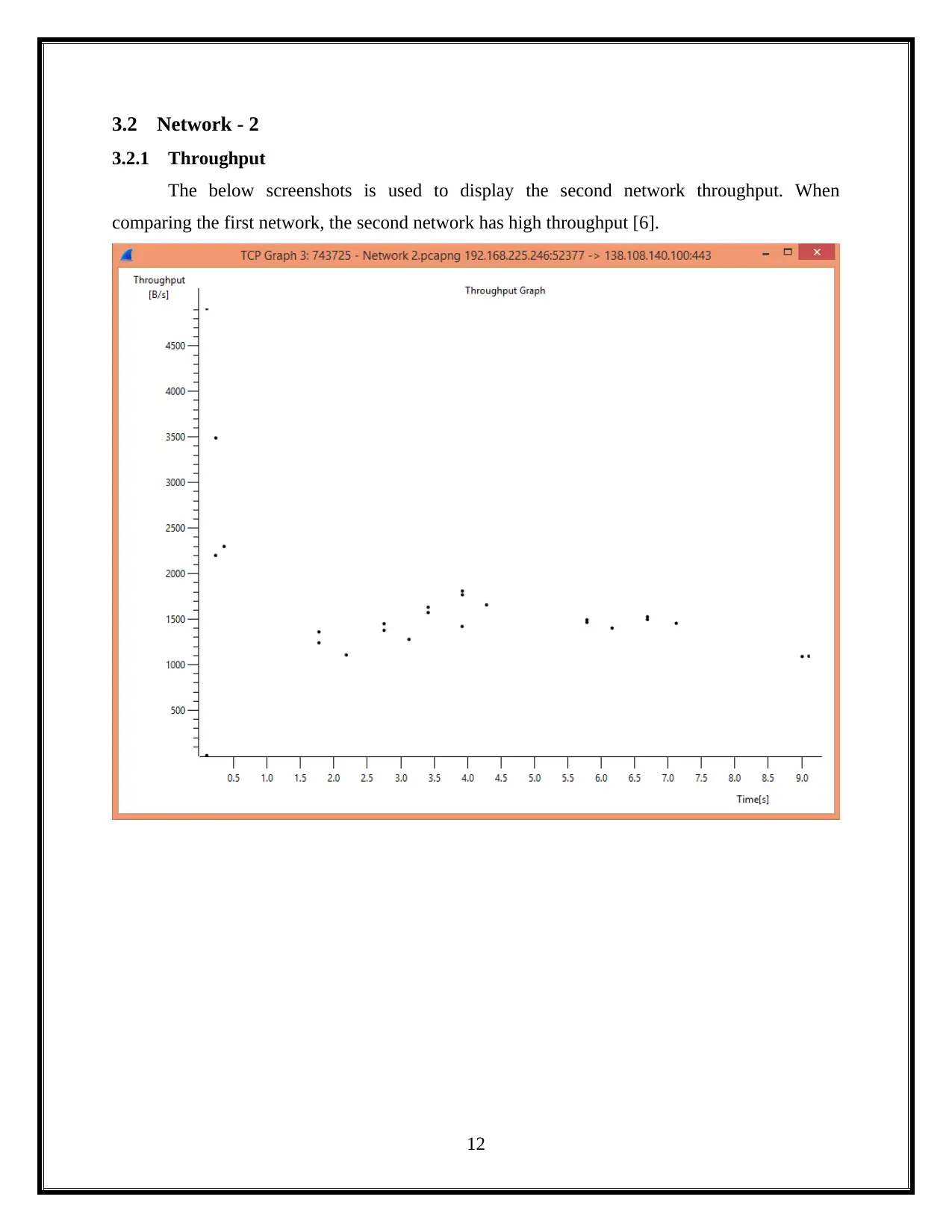
3.2 Network - 2
3.2.1 Throughput
The below screenshots is used to display the second network throughput. When
comparing the first network, the second network has high throughput [6].
12
3.2.1 Throughput
The below screenshots is used to display the second network throughput. When
comparing the first network, the second network has high throughput [6].
12
⊘ This is a preview!⊘
Do you want full access?
Subscribe today to unlock all pages.

Trusted by 1+ million students worldwide
1 out of 23
Related Documents
Your All-in-One AI-Powered Toolkit for Academic Success.
+13062052269
info@desklib.com
Available 24*7 on WhatsApp / Email
![[object Object]](/_next/static/media/star-bottom.7253800d.svg)
Unlock your academic potential
Copyright © 2020–2025 A2Z Services. All Rights Reserved. Developed and managed by ZUCOL.



